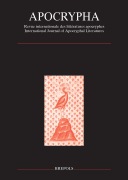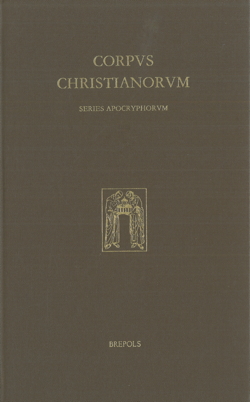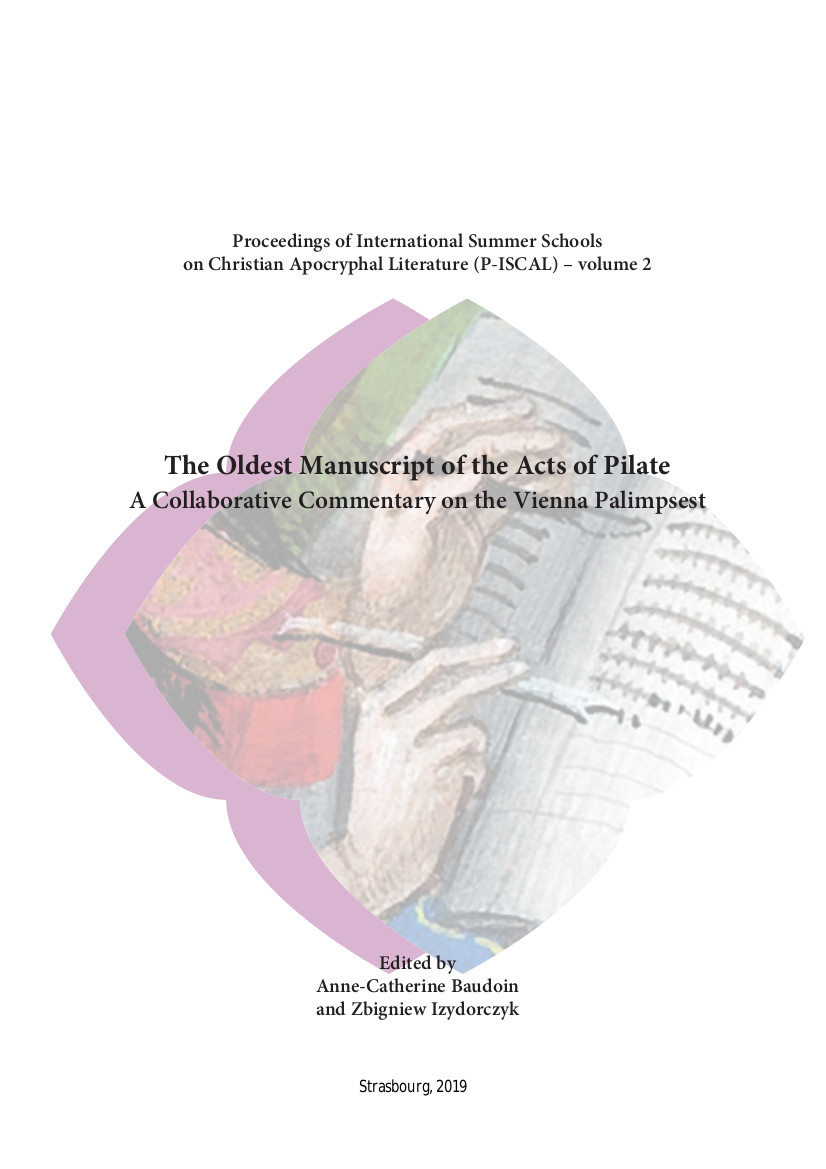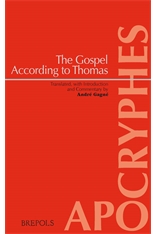Le volume 29 de la revue Apocrypha vient de paraître. Vous trouverez ci-dessous le résumé des article.
Sommaire
« The Coptic Martyrdom of Andrew », par Ivan Miroshnikov, p. 9-28
This article provides the editio princeps of the two parchment leaves housed at the Bibliothèque nationale de France in Paris – viz., Copte 12918 fol. 88 and Copte 12918 fol. 160 – which belong respectively to White Monastery codices MONB.GQ and MONB.DM. The leaves together witness the Coptic Martyrdom of Andrew (CANT 235), an Egyptian text that has little to do with the better-known Greek martyrdom of the apostle (CANT 225). In the introduction, the author discusses the sources and date of the text, as well as the connection of Andrew with the motif of fire. The author argues that the text was composed for liturgical purposes and that the shorter version of the Coptic Martyrdom of Andrew (represented by the two Coptic witnesses) is original, while the longer one (attested in Arabic and Ethiopic) is the result of a later redaction. The introduction is followed by a diplomatic edition of the Coptic fragments and an English translation.
Le présent article fournit l’editio princeps de deux feuilles de parchemin conservées à la Bibliothèque nationale de France à Paris – soit le Copte 12918 fol. 88 et le Copte 12918 fol. 160 – qui appartiennent à deux manuscrits du Monastère Blanc, respectivement le MONB.GQ et le MONB.DM. Il s’agit de deux témoins du Martyre d’André copte (CANT 235), un texte égyptien qui n’a que peu de rapports avec le martyre grec du même apôtre (CANT 225). Dans l’introduction sont discutées la question des sources et celle de la date du texte, tout comme celle du lien entre André et le motif du feu. L’auteur défend l’hypothèse que cette œuvre a été composée pour un usage liturgique et que la version brève du Martyre d’André copte (représentée par les deux témoins coptes) en est le texte primitif, tandis que la version longue (attestée en arabe et en éthiopien) est le fruit d’une rédaction ultérieure. L’introduction est suivie d’une édition diplomatique des fragments coptes munie d’une traduction anglaise.
« The Acts of Andrew and Philemon in Sahidic Coptic: Plates », par Ivan Miroshnikov, p. 29-33
The article “The Acts of Andrew and Philemon in Sahidic Coptic” by Ivan Miroshnikov, published in Apocrypha 28 (2017), contains references to four plates. Due to an oversight, these plates were not included in the publication. They are now published here.
« La danse entre polymorphie et métaphore. L’épisode de la danse des Actes de Jean dans son contexte littéraire », par Karin Schlapbach, p. 35-58
Cette contribution examine la relation entre la danse envisagée comme une pratique et comme une métaphore dans les Actes de Jean et dans le contexte littéraire auquel appartient ce document. Elle montre que la tension entre la pratique de la danse et sa transformation en métaphore peut être éclairée, d’une part, par un motif qui se trouve dans le contexte immédiat de l’épisode de la danse des Actes de Jean, à savoir la polymorphie de Jésus. Située entre le miraculeux et la fiction littéraire, la polymorphie de Jésus – une espèce de métaphore corporelle – associe paradoxalement le dynamisme corporel et l’idée d’un être sans substance. Elle fait voir et cache en même temps. Le contexte littéraire plus large, d’autre part, privilégie clairement les usages métaphoriques de la danse – la danse de l’âme et des astres. Bien que ces idées soient présentes également dans les Actes des Jean, l’hymne de la danse est exceptionnel par l’attention qu’il porte à l’expérience corporelle des danseurs.
This essay examines the relationship between dance as a practice and as a metaphor in Acts of John and in the literary context to which this text belongs. It argues that the tension between dance as a practice and as a metaphor can be elucidated on the one hand by a motif that is found in the immediate context of the dance hymn in Acts of John, namely the polymorphy of Jesus. Located in a grey area between the miraculous and the fictional, Jesus’ polymorphy – a physical metaphor of sorts – paradoxically combines physical dynamism and insubstantiality, and it hides as much as it shows. The larger literary context, on the other hand, tends to eclipse the body by privileging the metaphorical dances of the soul and the stars. While these ideas are also present in Acts of John, the dance hymn stands out for the attention it gives to the physical experience of the dancers.
« A Quotation from 6 Ezra in the Sermo asceticus of Stephen the Theban », par Alin Suciu, p. 59-67
This article identifies a quotation from 6 Ezra in Stephen the Theban’s Sermo asceticus, a fourth- or fifth-century Egyptian ascetical treatise. Together with P. Oxy. 1010 (c.fourth century), the quotation in Stephen’s Sermo asceticus represents the earliest attestation of 6 Ezra.
Le présent article met en évidence une citation de 6 Esdras dans le Sermo asceticus d’Etienne le Thébain, un traité ascétique égyptien du ive ou ve siècle. Avec le P. Oxy. 1010 (env. ive siècle), cette citation dans le Sermo asceticus représente la plus ancienne attestation de 6 Esdras.
« Épicure et Bardesane astrologues : l’exposé de Nicétas au livre VIII des Recognitiones pseudo-clémentines », par Jeffery Aubin, p. 97-111
La théorie atomiste, dans le discours contre l’astrologie du livre VIII des Recognitiones, correspond très peu à la pensée d’Épicure, même si le rédacteur du roman affirme réfuter ce dernier. On invoque généralement une méconnaissance de la philosophie grecque pour expliquer cette anomalie. Or la théorie réfutée au livre VIII partage beaucoup de similitudes avec les idées du philosophe syrien Bardesane. Ce dernier avait donné une place importante aux atomes dans sa cosmologie et il est possible que le rejet du système épicurien vise plutôt le déterminisme astral, accepté en partie par Bardesane. Le rédacteur du roman, par l’exposé de Nicétas, tenterait de renverser l’idée bardesanite voulant que les inégalités parmi les hommes soient le résultat de la volonté des astres. Tandis que les Recognitiones sont en accord avec le philosophe syrien affirmant que les astres n’ont aucun effet sur la volonté libre de l’homme – reprenant même sa pensée au livre IX -, elles s’opposent à l’idée voulant que les astres soient à l’origine des inégalités entre les hommes. L’amalgame de la pensée d’Épicure et de Bardesane viserait à réfuter tout déterminisme, que ce soit celui de l’épicurisme ou encore le fatalisme astral bardesanite.
The atomistic theory, in the argument against astrology in Book VIII of the Recognitiones, corresponds very little to the thought of Epicurus, even though the writer of the novel claims to refute him. Scholars explain this discrepancy as a misunderstanding of Greek philosophy by the author of the Recognitiones. However, the theory refuted in Book VIII shares many similarities with the cosmology of the Syrian philosopher Bardaisan. The latter gives an important place to atoms and it is possible that the rejection of the Epicurean system is directed against astral determinism, accepted in part by Bardaisan. The discourse of Nicetas would attempt to overthrow the Bardaisanian idea that inequalities among men are the result of the power of the stars. While the Recognitiones are in agreement with the Syrian philosopher who thinks that the stars have no effect on the free will of man – reproducing his thought in Book IX – they are opposed to the idea that the inequalities among men are the result of astral fatalism. The synthesis of Epicurus and Bardaisan would aim at refuting all determinism, be it Epicurean or Bardaisanian.
« A Survey of the Manuscripts of the Syriac History of John », par Jacob A. Lollar, p. 113-136
In this essay, I have provided a brief overview of the extant manuscripts for the Syriac History of John the Son of Zebedee, a fourth- or early fifth-century apocryphal legend that probably came from Edessa. William Wright published a text and translation of the History of John in the late nineteenth century using two manuscripts. Since then, several other manuscripts of this text have been identified. Here, I present a summary of all known manuscripts of the History of John toward the goal of compiling a new text and translation in the near future.
Je présente ici un bref aperçu des manuscrits existants de l’Histoire syriaque de Jean fils de Zébédée, une légende apocryphe du ive ou du début du ve siècle, probablement écrite à Édesse. À la fin du xixe siècle, William Wright a publié un texte et une traduction de l’Histoire de Jean, en utilisant deux manuscrits. Depuis lors, plusieurs autres témoins de ce texte ont été identifiés. Ici, je présente tous les manuscrits connus de l’Histoire de Jean avec l’objectif d’éditer, dans un avenir proche, un nouveau texte et une nouvelle traduction.
« The So-Called Seven Seals of Christ and Their Explanation as Presented by various versions of the Abgar Legend and the Miniature of the Edessan Image from the Oxford Menologion (Codex gr. th. f. 1 (S. C. 2919), Bodleian Library », par Irma Karaulashvili, p. 137-182
The present article offers an overview of the origins and development of a small passage from the Greek version of the famous apocryphal letter of Christ to the King of Edessa, Abgar. This passage of apotropaic character, consisting of either four or seven Greek letters/seals, is usually followed by their explanation. The earliest evidences of attaching the seals to the letter of the Saviour and their Latin counterpart(s), as well as their relationship to the concept of the divine names are discussed. A reconstructed probable Syriac original, together with plausible reasons for inclusion of the observed phenomenon within the main body of the apocryphon is provided. Examples of the iconographical seals of Christ, attached to the acheiropoi?tos image (Mandylion) of the Saviour preserved in Georgian and Cappadocian representations of the relic are examined and their correlation with the seals attached to the epistle of Jesus is verified. Finally, an attempt to prove that the miniature containing the Edessan image from the fourteenth-century Oxford Menologion preserves earliest mode of painting the seals on the cloth of the acheiropoi?tos image is given.
Le présent article offre une vue d’ensemble des origines et du développement d’un petit passage de la version grecque de la fameuse lettre apocryphe du Christ au roi d’Édesse, Abgar. Ce passage de caractère apotropaïque, qui comporte soit quatre lettres/sceaux soit sept, est généralement suivi de son explication. Nous analyserons ici la plus ancienne attestation des sceaux fixés à la lettre du Sauveur et ses équivalents latins, tout comme ses relations avec le concept de « noms divins ». Nous fournirons également une reconstitution de l’original, probablement syriaque, et nous exposerons les raisons plausibles qui ont pu conduire à l’inclusion du motif observé dans le corps principal de l’écrit apocryphe. Nous examinerons alors des exemples d’illustration des « sceaux du Christ » liés à l’image acheiropoi?tos du Sauveur (Mandylion), qui sont conservés dans des représentations géorgiennes et cappadociennes de cette relique et nous vérifierons leur corrélation avec les sceaux attachés à l’épître de Jésus. Finalement, nous essaierons de prouver que la miniature de l’image édessénienne contenue dans le Ménologe d’Oxford du xive siècle préserve un mode très ancien de représentation picturale des sceaux sur le tissu dans l’image acheiropoi?tos du Christ.
« “La Gloire du Liban viendra chez toi” (Is 60,13) : à l’origine de la légende du bois de la croix », par Gavin McDowell, p. 183-201
La légende du bois de la croix est un cycle médiéval narrant la préhistoire de la croix du Christ, jadis possédée par des personnages bibliques tels que Seth, Moïse et Salomon. Dans sa forme la plus développée, cette légende est une suite de la quête de Seth pour obtenir l’huile de la vie, une tradition existant dans toutes les versions de la Vie d’Adam et Ève.Pourtant, un examen des versions plus anciennes de la légende ainsi que des textes orientaux peu connus révèle que l’épisode de Seth n’est pas originel et que le cœur de la légende véhicule l’idée que le bois de la croix avait auparavant appartenu au Temple de Salomon. Cette idée vise à rattacher le sacrifice expiatoire de Jésus avec le Temple.
The Legend of the Wood of the Cross is a medieval cycle of stories explaining the prehistory of the cross of Christ, which had previously been in the possession of such biblical worthies as Seth, Moses, and Solomon. In its most developed form, this Legend is a continuation of the story of the quest of Seth for the oil of life found in all versions of the Life of Adam and Eve. However, an examination of earlier versions of the Legend as well as lesser-known oriental texts reveal that the Seth episode is not original to the Legend and that the core of the Legend is the idea that the wood of the cross had once been part of the Temple of Solomon. This idea derives from a desire to connect Jesus’ atoning sacrifice with the Temple.
Recensions, p. 203-250
Gruen, Erich S., The Construct of Identity in Hellenistic Judaism: Essays on Early Jewish Literature and History (Deuterocanonical and Cognate Literature Studies 29), Berlin – Boston, Walter de Gruyter, 2016, xiv + 574 p. ISBN 978-973-911-037302-8
Vercruysse, Jean-Marc (dir.), La résurrection de Lazare (Graphè 26), Arras, Artois Presses Université, 2017, 230 p. ISBN 978-972-84832-274-272
Tervahauta, Ulla, Miroshnikov, Ivan, Lehtipuu, Outi, et Dunderberg, Ismo (éd.), Women and Knowledge in Early Christianity (Supplements to Vigiliae Christianae 144), Leyde – Boston, Brill, 2017, x + 379 p. ISBN 978-990-04-35543-9
Norelli, Enrico etCameron, Averil, Markion und der biblische Kanon / Christian Literature and Christian History, Berlin – Boston, Walter de Gruyter, 2016, xv + 53 p. ISBN 979-910-320-0105-0109
Markschies, Christoph et Schröter, Jens (éd.), en collaboration avec Andreas Heiser, Antike christliche Apokryphen in deutscher Übersetzungen, 7. Auflage der von Edgar Hennecke begründeten und von Wilhelm Schneemelcher fortgeführten Sammlung der neutestamentlichen Apokryphen, I. Band : Evangelien und Verwandtes, Teilband 1, Teilband 2, Tübingen, Mohr Siebeck, 2012, xxv + 1468 p. ISBN 978-973-916-150087-9 (Leinen, in 2 Teilbänden) ; 978-973-916-149951-7 (fadengeheftete Broschur, in 2 Teilbänden)
Piovanelli, Pierluigi et Burke, Tony (éd.), Rediscovering the Apocryphal Continent. New Perspectives on Early Christian and Late Antique Apocryphal Texts and Traditions (Wissenschaftliche Untersuchungen zum Neuen Testament 349), Tübingen, Mohr Siebeck, 2015, 439 p. ISBN 978-973-916-151994-9
Zwierlein, Otto, Petrus in Rom: Die literarischen Zeugnisse. Mit einer kritischen Edition der Martyrien des Petrus und Paulus auf neuer handschriftlicher Grundlage, 2., durchgesehene und ergänzte Auflage (Untersuchungen zur antiken Literatur und Geschichte 96), Berlin – New York, Walter de Gruyter, 2010, 486 p. ISBN 978-973-911-048849-4
Calzolari, Valentina, Apocrypha armeniaca I: Acta Pauli et Theclae, Prodigia Theclae, Martyrium Pauli (Corpus Christianorum. Series Apocryphorum 20), Turnhout, Brepols, 2017, 738 p. ISBN 978-972-503-56986-34
Augustin, Philip,Die Juden im Petrusevangelium. Narratologische Analyse und theologiegeschichtliche Kontextualisierung (Beihefte zur Zeitschrift für die neutestamentliche Wissenschaft 214), Berlin, Walter de Gruyter, 2015, xii + 455 p. ISBN 978-973-911-040572-9
Grosso, Matteo, Vangelo secondo Tommaso, Introduzione, traduzione et commento (Classici 12), Rome, Carocci editore, 2011, 302 p. ISBN 978-988-430-6040-6045
Lundhaug, Hugo et Jenott, Lance, The Monastic Origins of the Nag Hammadi Codices (Studien und Texte zu Antike und Christentum 97), Tübingen, Mohr Siebeck, 2015, 332 p. ISBN 978-973-916-154172-8
Jorgensen, David W., Treasure Hidden in a Field. Early Christian Reception of the Gospel of Matthew (Studies of the Bible and Its Reception 6), Berlin – Boston (Mass.), Walter de Gruyter, 2016, xv + 321 p. ISBN 978-973-911-047655-2
Kaler, Michael, Flora Tells a Story, The Apocalypse of Paul and Its Contexts,Waterloo (CA), Wilfried Laurier University Press, 2008, xiv + 258 p. ISBN 978-971-55458-044-046
Seng, Helmut, Un livre sacré de l’Antiquité Tardive : Les Oracles Chaldaïques, (Bibliothèque de l’école des hautes études – Sciences religieuses), Turnhout, Brepols, 2016, 149 p. ISBN 978-972-503-56518-7
Minale, Valerio Massimo, Legislazione imperiale e manicheismo da Diocleziano a Costantino, Genesi di un eresia (Diaphora 15), Naples, Jovene Editore, 2013, 279 p. ISBN 978-988-243-2275-2271
Mani in Dublin. Selected Papers from the Seventh International Conference of the International Association of Manichaean Studies in the Chester Beatty Library, Dublin, 8-12 September 2009, Siegfried G. Richter, Charles Horton, Klaus Ohlhafer (éd.) (Nag Hammadi and Manichaean Studies 88), Leyde – Boston, Brill, 2015, 459 p., ISBN 978-990-04-28836-2
Gardner, Iain, BeDuhn, Jason, et Dilley, Paul, Mani at the Court of the Persian Kings. Studies on the Chester Beatty Kephalaia Codex (Nag Hammadi and Manichaean Studies 87), Leyde – Boston, Brill, 2015, 320 p. ISBN 978-990-04-23470-3
Wilkens, Jens, Das Buch von der Sündentilgung, Edition des alttürkisch-buddhistischen (Berliner Turfantexte XXV, 1 et 2), Turnhout, Brepols, 2007, Teil 1 – Teil 2, 607 p. + 51 planches, ISBN 978-972-503-52621-8 (2 volumes)
The Arts of Editing Medieval Greek and Latin: A Casebook, Göransson, Elisabet, Iversen, Gunilla, Crostini, Barbara, Jensen, Brian M., Kihlman, Erika, Odelman, Eva, and Searby, Denis (éd.) (Studies and Texts 203), Toronto, Pontifical Institute of Mediaeval Studies, 2016, xix + 452 p. ISBN 978-970-88844-203-201



